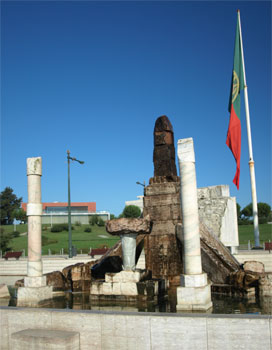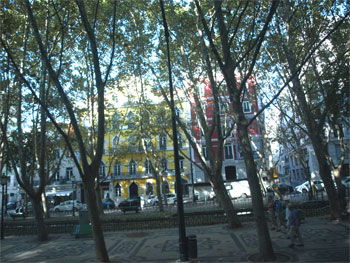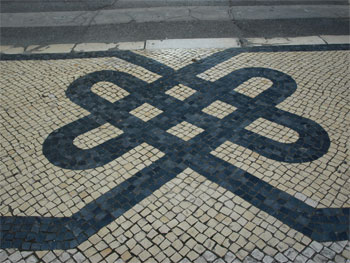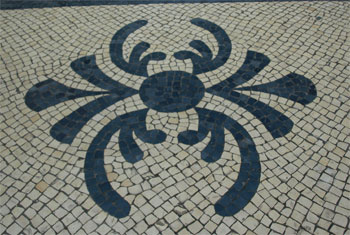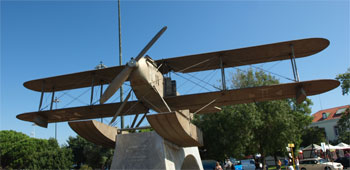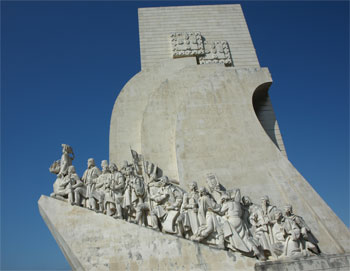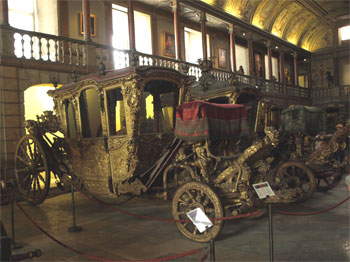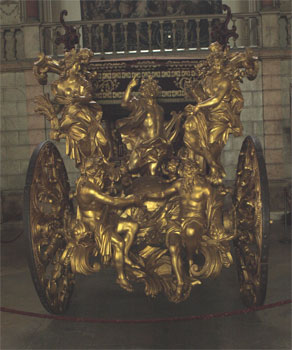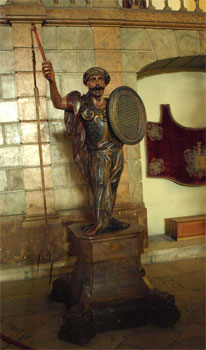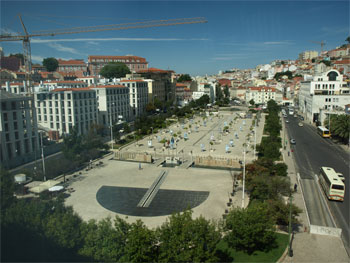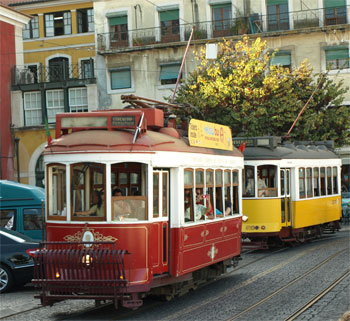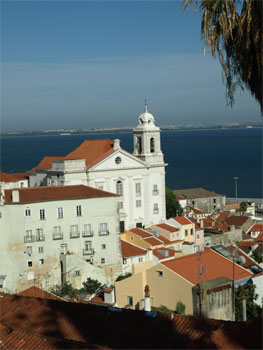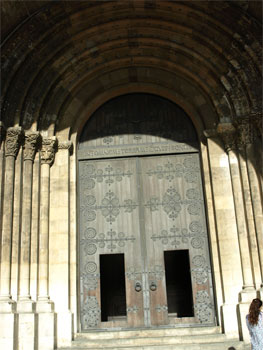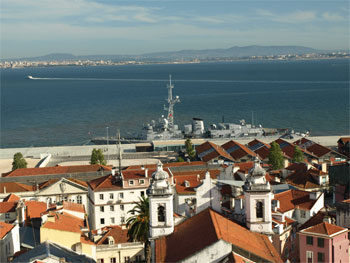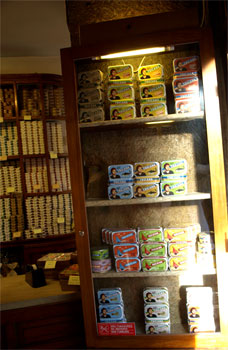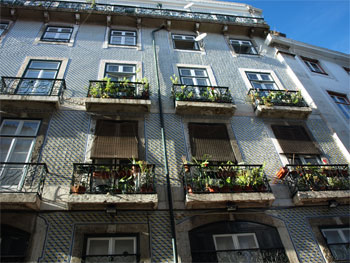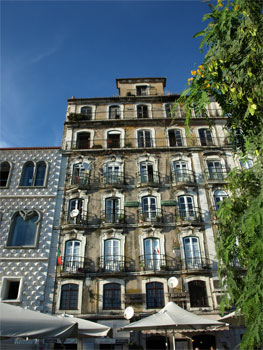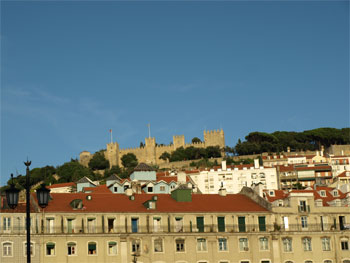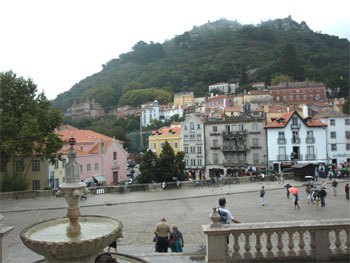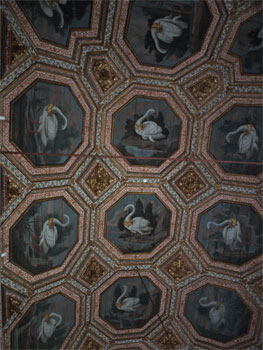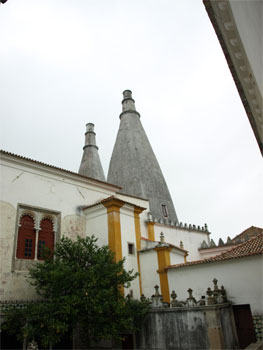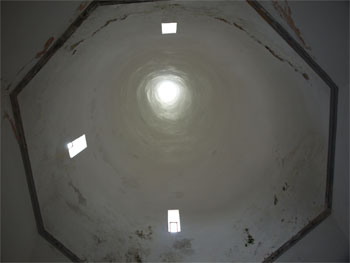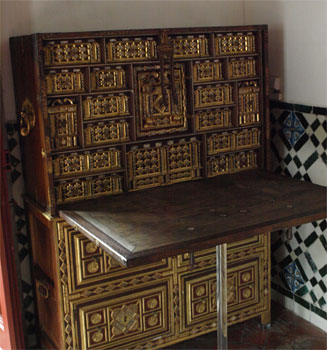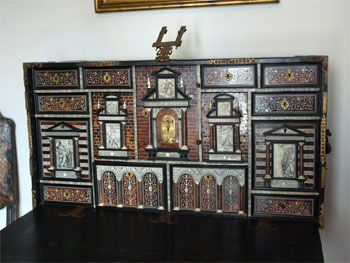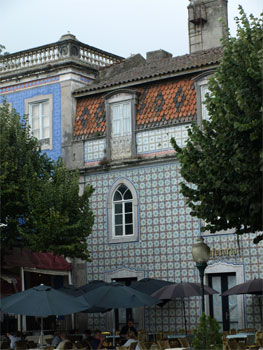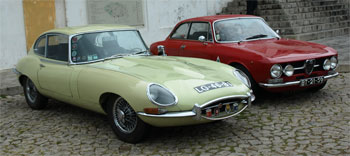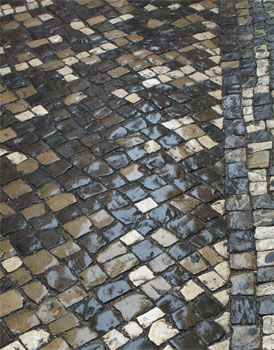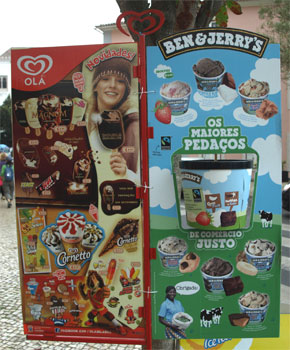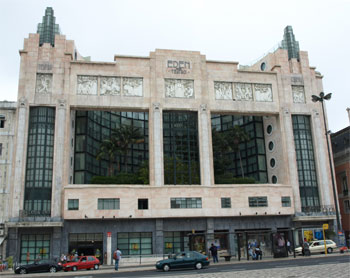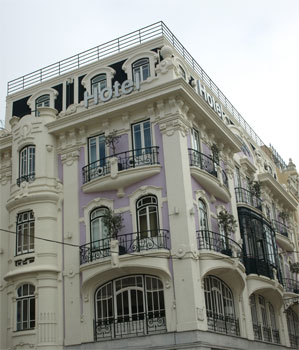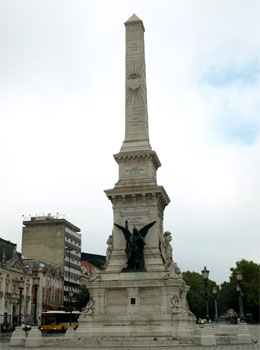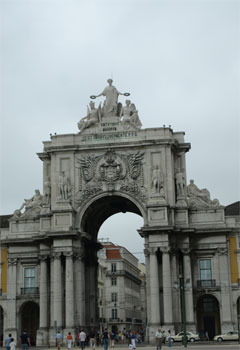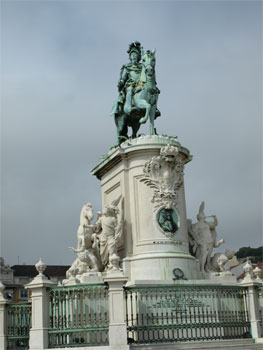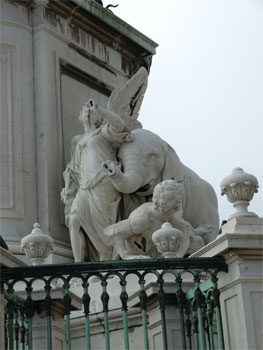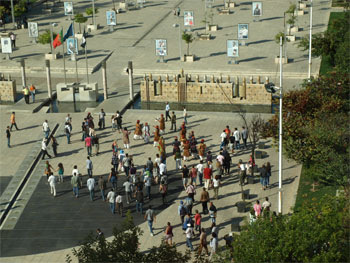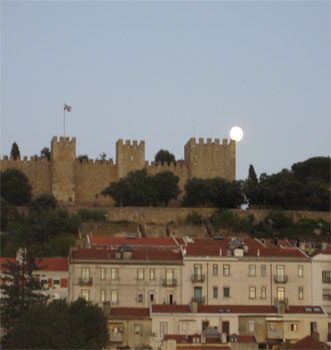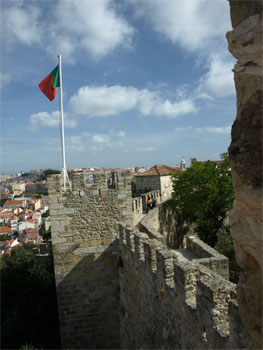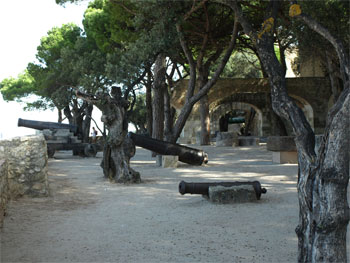Fri., 9/9/11 - Lisbon, Portugal
This morning we had an excellent local tour guide for a sightseeing tour of Lisbon. We passed the monument and statue to the Marquis Pombol. Lisbon was demolished in an earthquake (9 on the Richter Scale) and fire and tsunami wave in 1755. It was rebuilt by Pombol, who later became a marquee. He replaced the narrow crooked alleys with a grid of streets while the king just went into hiding! We continued up to an overlook of the city from the monument "April 25, 1974," which commemorates the rebirth of the republic of Portugal after two dictatorships, a coup d tat, and a year under failed communist rule. The stone in front is an abstract carnation because carnations were placed in gun and cannon barrels saying, "peace, not blood." We looked down on the downtown between two of Lisbon's seven hills.
The tops of the street light poles have a ship with a raven at the bow and stern. It is the symbol of Lisbon. The sidewalks are all made with black and white three-inch square stone blocks that are in patterns.
Statue of the Marques de Pombal
|
Monument to the "Carnation Revolution" of April 25, 1974 |
Symbol of Lisbon
|
Street scene with mosaics in the sidewalk |
Sidewalk mosaics
|
Sidewalk mosaics |
Our next stop was at the 500-year-old port area on the River Tagus. Ships from the four corners of the world entered here to unload their riches and all sailors leaving attended mass and received the sacraments and confession at the monastery before sailing out from here. The Belem Tower was built in 1515 and welcomed adventurers home. A chain was once stretched across the river from this tower to keep out pirates. The tower, which was not destroyed in the1755 earthquake, is decorated with images of rope, seashells, and a rhino! (One of the ships carrying a rhino back to Lisbon sank in the Atlantic not far from the port.) At this port there is a replica of the first plane (a seaplane) to cross the Atlantic in 1922. Unlike Lindberg, this one made several stops on the way to Brazil.
Belem Tower |
Rhino sculpted into the tower
|
Replica of the first seaplane to cross the Atlantic
|
Next we stopped at a wonderful monument and museum of Discovery. The monument is shaped like the prow of a ship with a 30-foot tall statue of Henry the Navigator at the front. Other historic Portuguese mariners are 20 feet tall and include De Gama, Magellan, Cabral - who first landed in Brazil, etc. The only woman on the monument is Henry the Navigator's mother, Queen Felipa of Lancaster.
|
Discoveries Monument |
Henry the Navigator's mother, Queen Felipa of Lancaster - the only woman on the monument
|
Next stop was the Coach Museum. There are 70 royal coaches made by Polish, French, and English designers. The oldest is from 1609. Some are very elaborate with gold leaf over carved wood statuary and velvet and silk lined carriage boxes. Some of the coaches were donated more recently and included children's goat or pony carriages and coaches for hire, called carioles from which comes the term, "call a cab."
|
Coach Museum
|
Coach Museum
|
Coach Museum |
Aqueduct of the Free Waters
|
View from our hotel room of Martim Moniz Square |
After a rest period and lunch we met for a Lisbon tram ride up to the Alfama, the oldest district of the city, where St. George's Castle and the Lisbon cathedral are located. The trams are old-fashioned small trolleys that can wind their way up the hilly, narrow, twisted streets. At the top we looked down over the residential roofs and to the river. The cathedral is rather plain and unremarkable but was not a recycled mosque. On the way back down to the center of downtown we stopped at a fish cannery store. Sardines, anchovies, etc. are preserved then canned at this store and a woman hand wraps the paper label. The process has been done the same way since 1930. The building facades are an interesting mix of older tile and modern designs, often side-by-side.
Typical tram
|
Decorated tram |
St. Vincent de Fora church and monastery |
Views from Miradouro (terrace) das Portas do Sol
|
Doors of the Cathedral of St. Mary Major - Lisbon Cathedral
|
Warship docked |
Fish canning store
|
Building facade - older, tile faced |
Newer facades (left) beside the older
|
St. George's Castle atop the hill (from our hotel) |
Sat., 9/10/11 - Lisbon, Sintra, and Cascais, Portugal
We finally hit a day of rain. It started as a mist and became a drizzle but it was warm and we did not get soaked.
Our tour today was an optional one to the Atlantic coastal towns of Estoril, Cascais, and Sintra.
This area of western Portugal became the home for many exiled nobility and influential Europeans during WWII, especially from Italy, Bulgaria, and Romania, as well as many Jews. Cascais became known as the village of kings and fishermen. (Portugal stayed friendly with both the Allies and Germany.) As a result there are many 20th c. mansions/estates along the coast but it was far too rainy to take pictures or explore the little town.
We then drove inland up into the Sintra Mountains - not very high, but with pine trees and many boulders, to the town of Sintra.
The royal summer palace of King John I and Queen Felipa of Lancaster (British), the parents of Henry the Navigator, is in Sintra. It was built below the site of a 9th c. fortress of the Moors.
Castle of the Moors On hill) with the
|
We toured the Palace interior, walking through and finally ending in the kitchen. The kitchen had two bread ovens, a row of cooking stoves with large copper pots, a spit, and a dish warmer all below the two large chimneys. The thing that was so interesting about this palace is the fact that it had many furnishings in place from at the latest, the 18th c. There were many ornate chests probably used to move from palace to palace, large armoires, heavy ornately carved tables, several fancy desks, leather-bound chairs, and four-poster beds. The walls were mostly ceramic tiles and the floors were done in plain red glazed brick tiles.
|
Ceiling of the Swan Room
|
Kitchen |
Twin chimneys
|
Looking up one of the chimneys from the kitchen |
|
|
It rained some more but we stopped at a bakery to buy the Sintra specialty pastry called "travesseiros." They are phyllo dough with a creamy inside and sugar and cinnamon on top.
|
|
Building facade |
Gale insisted on this picture of the vintage cars parked outside the castle |
Walking on these wet cobblestones on the hilly streets was very challenging
|
Everywhere! |
Back in Lisbon we walked the downtown to take some pictures and eat lunch again at the Pastelaria Suica restaurant and watch people in Rossio Square. It sprinkled a few more times but we took pictures of the train station with a Starbucks, the Eden Teatro, the Obelisk in Restauradores Square, the elevator tower designed by Eiffel, the arched entry to town on Rua Augusta (the pedestrian mall with many sidewalk cafes and shops) and the statue of Joseph I (with an elephant at the base) down by the river front.
Lisbon train station
|
Eden Theater |
Building facade
|
Restauradores Square - Obelisk commemorating liberation from the Spanish |
Viewing elevator designed by Eiffel
|
Viewing elevator designed by Eiffel |
Rue Augusta Arch at the entrance to Commerce Square |
Commerce Square
|
Statue of King Jose I in Commerce Square |
Elephant and others at the base of the statue of King Jose I
|
We had seen a group of interesting musicians and actors in one of the squares and when we returned to our hotel they were entertaining in the square below us.
|
|
Group of musicians/actors in Martim Moniz Square |
Group of musicians/actors in Martim Moniz Square
|
Tonight was our farewell dinner on the top floor of the hotel. We had a great view of the castle, the river, and downtown. We saw the full moon rise over the castle tower.
|
Moon rising over St. George's Castle
|
Sun, 9/11/11 - Lisbon Portugal to Barcelona, Spain
This morning we took a taxi up the steep hill to Castelo de Sao Jorge (St. George’s Castle). The fortress was originally built by 11th c. Arabs but the archeological digs on the hill indicate that civilization was here in the 7th c. BC. We climbed the many steep short steps and walked around the ramparts and on top of several of the eleven towers. The views over all of Lisbon were great.
St. George's Castle - wall and ramparts
|
Cannon in the courtyard at St. George's Castle |
Tagus River and Commerce Square from St. George's Castle
|
Views of Lisbon from St. George's Castle |
Current archeological digs |
Street scene on the walk back to the hotel
|
Back at the hotel, we packed up and took a taxi to the Lisbon Airport, a short ride, and flew back to Barcelona, Spain. We stayed at the same Salles Ciutat Del Prat hotel where we stayed after our Mediterranean cruise. It was late so we ate at the hotel restaurant. It was probably the most expensive meal on our five weeks of travel.
Mon., 9/12/11 - Barcelona, Spain to Estes Park
We took the shuttle back to the airport and flew Delta to Denver through Atlanta. The flights were okay and we got back early enough to drive home.
It is good to be home, but this was another very interesting, educational, and fun trip and we hope to return to Spain and Portugal again.
Return to Trips page to view other trips.
| Return to Top | Return to Itinerary | Return to Dreamcatcher Home Page |

